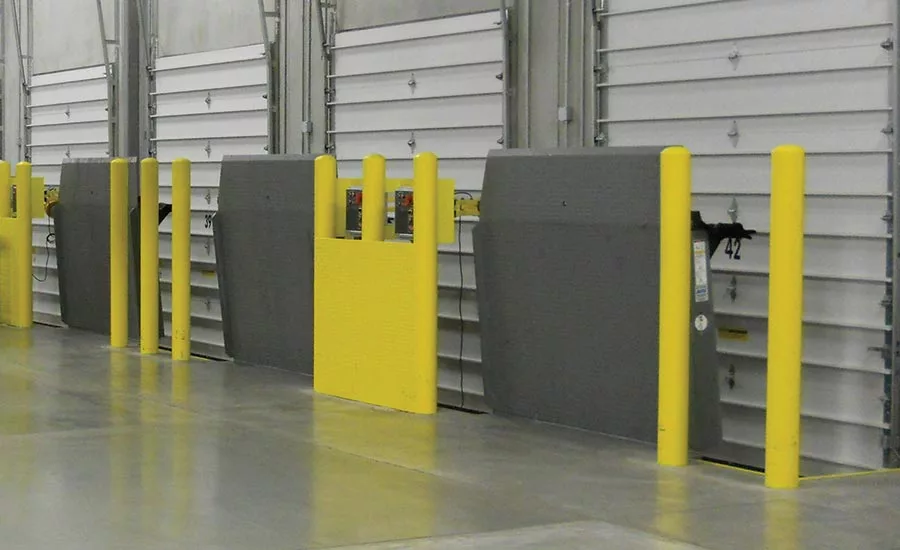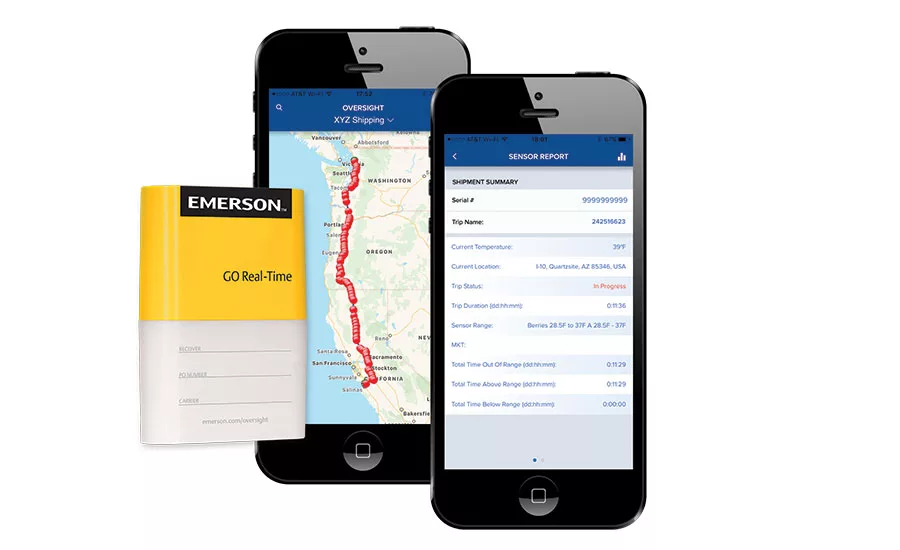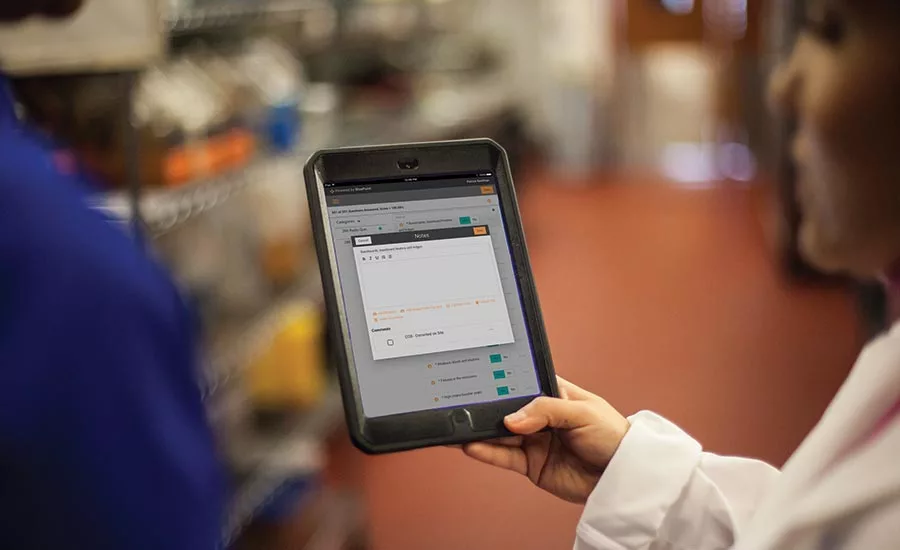Food Safety
The effects of FSMA's sanitary transportation of food rule
Regulation establishes requirements designed to minimize risk during the transportation of food and beverages that could compromise its safety

More visibility in both tracking and tracing from RFID tags helps manufacturers provide cost-efficient and high-quality products to their customers.
Photo courtesy of EU Automation

More visibility in both tracking and tracing from RFID tags helps manufacturers provide cost-efficient and high-quality products to their customers.
Photo courtesy of EU Automation

To verify adherence to cold chain protocols, GO Real-Time trackers from Emerson can be placed on a load. The processor can input the serial number of the unit into Emerson’s mobile app and know the temperature and location of the product in real time. Real-time alerts via text and email can also be set up.
Photo courtesy of Emerson

The RTR-601 Food Core temperature data logger from T&D records temperature data that can be automatically sent via wireless communication to a designated email address or an FTP server.
Photo courtesy of CAS DataLoggers

RizePoint’s Mobile Auditor app provides companies tools for performing audits anywhere and also syncs with Bluetooth thermometers and IoT networks.
In April 2018, another FSMA deadline occurred for many involved in the movement of human and animal foods—the Sanitary Transportation of Food (STF) rule.
This regulation establishes requirements designed to minimize risk during the transportation of food and beverages that could compromise its safety, from failing to properly refrigerate food to inadequately cleaning vehicles between loads. Larger businesses had to be in compliance by April of last year, and smaller businesses had an additional year.
“FDA adopted an ‘educate before we regulate’ approach, but … expect to see gradual enforcement and inspections occurring,” says Amy Childress, VP of marketing and planning for Emerson Cargo Solutions.
Article Index:
The STF rule assigns the responsibility of determining appropriate transportation operations onto the shipper, unless a written contract states otherwise.
“The ‘shipper’ is defined as ‘A person, e.g., the manufacturer or freight broker, who arranges for the transportation of food in the United States by a carrier or multiple carriers sequentially,’” says Childress.
So, if processors are the entities responsible for shipping product, this rule could have an impact on them.
“Processors should be aware of the FSMA rule to ensure accountability,” says Jesse Dowdle, CTO for RizePoint, which offers quality management software. “In a nutshell, the more processors can help shippers comply the better off each party will be when it comes to increasing food safety and limiting supply chain disruption due to noncompliance.”
Farm to table protection
As stated by FDA, the rule on Sanitary Transportation of Human and Animal Food advances “FDA’s efforts to protect food from farm to table by keeping them safe from contamination during transportation.” The rule was part of the original seven proposed in January 2013 in order to modernize the US food safety system.
In the industry, sanitary breaches in the cold chain are not unknown. Terry Nagy, engineering manager for CAS DataLoggers, says some of its customers purchased data loggers to investigate transportation issues regarding the refrigeration of food. He says the most common cause of temperature problems in transit is refrigeration equipment failing or running out of fuel. But there have been more nefarious causes.
“We have also heard of cases where drivers turned off the system during the middle of the trip to conserve on fuel,” Nagy says. “The food was cool at the start and at the end, but not in the middle. Another issue we have seen is the temperature jumping if the carrier makes multiple stops and leaves the doors open to load/unload product.”
Subjected to the STF rule are those that ship, load, carry by motor or rail vehicle and receive human and animal food, with some exceptions, such as exporters that ship food through the US, but the food does not enter US distribution.
“The STF rule does not, specifically, identify processors as part of this continuum,” says Stephen Neel, PhD and senior technical director for the Global Cold Chain Alliance (GCCA). “However, the shipper [the person who arranges the shipment] is ultimately responsible for providing all others with the written specifications of transport. These specifications would include, but are not limited to, packaging, handling, refrigeration and transport specifications, which would need to be provided by the processor who made the food item.”
FDA has outlined four primary areas that the STF rule establishes requirements for:
- Vehicles and transportation equipment: All vehicles and equipment used in shipping food must be designed and maintained to ensure food safety. This includes the cleanability of equipment, as well as the ability to maintain food safe temperatures.
- Transportation operations: There must be measures taken to ensure food safety during transit, such as temperature controls, the prevention of raw food contaminating ready-to-eat foods and the protection of food from other contaminating entities, including non-food items or allergens.
- Training: Carrier personnel must be trained, and have documentations to prove it, in sanitary transportation practices.
- Records: Written procedures, agreements and training documents must all be maintained.
Key sanitation requirements
While the STF rule mostly pertains to shippers and carriers, a food and beverage producer should know if its transporters have established programs to verify their vehicles meet hygiene and temperature control requirements.
“The backbone of the STF rule is communication of best practices between integrated partners,” says Neel. “Since the processor is the most knowledgeable about the product being transported, they play a significant role in communicating the specific food safety and temperature requirements that must be maintained to avoid a food safety risk. Processors should prepare by ensuring that each product [or product category] being transported has clear and written specifications associated with them.”
Additionally, Childress says processors should make sure an adequate recordkeeping method is in place to document ongoing adherence to safe transport processes.
“This includes documentation regarding proper sanitation of vehicles, proper refrigeration during transport and verification of adequate employee training on proper safe pre-cooling and transport procedures,” she says.
To avoid being noncompliant and possibly facing civil and criminal penalties, RizePoint’s Dowdle advises processors review and audit their current processes.
“Among other things, you’ll especially want to look at preventative actions you can take and how strong your traceability controls are up and down your supply chain,” he says.
Also, Neel says taking into consideration the proper design, maintenance and cleaning of transport vessels is a best practice not to be ignored.
“Avoiding the use of chemicals that can pit or damage the interior is critical, as are timely cleaning and inspection of vehicles and trailers,” he says. “The sanitary condition of the vessel, including cleanliness, odor and pest control, is an industry best practice that should be monitored on an ongoing basis.”
To manage the sanitary environment of their receiving areas, processors should use a drive-through application at their loading docks, says Chad Dillavou, product manager for Rite-Hite Products Corp. This approach, which uses a combination of a vertically stored leveler and a dock shelter, allows facility personnel to load or unload trucks, including securing the doors, all within the confines of an enclosed dock.
“By restricting loading dock doors from opening to the outside, contamination concerns like pests and weather are minimized,” he says. “A vertical leveler [when in the stored position] allows the loading dock door to close directly on the pit floor instead of on the leveler.”
This solution minimizes not only outside air infiltration and reduces energy lost, it also improves the hygiene of the plant, because the leveler’s upright storage allows easier cleaning of the pit floor, says Dillavou.
Once product does arrive at the plant, delivery trucks should be inspected.
“Point-of-inspection audits are key to food safety,” Dowdle says. “For example, some clients use RizePoint to do inspections of trucks where samples are taken from the back, front and middle of the load to ensure consistency of temperature, ripeness and other safety and quality markers.”
The importance of temperature control
To prevent food safety problems, the STF rule emphasizes that adequate temperature controls should be maintained throughout the duration of transporting food.
“Sections 1908(c), (d) and (e) require the carrier be able to demonstrate that the temperature conditions were maintained, from when the product was loaded through transport to delivery, and that the food was not subjected to significant temperature abuse,” says CAS DataLoggers’ Nagy. “I don’t believe there was any previous requirement for continuous temperature monitoring during shipment.”
For this reason, temperature recorders are becoming a must to ensure, as well as prove, that food has been protected during shipping.
“Temperature recorders provide a complete journey profile of time and temperature,” says Angela Kerr, vice president of product portfolio and program management for SpotSee, an end-to-end solution provider that enables its customers to see, in real time, operational problems.
She says these recorders allow companies to see any trouble spots in their cold chain and can help validate their supply chain.
Childress agrees and says Emerson’s temperature monitoring devices provide insight into what happens to food in the cold chain.
“We’ve witnessed some interesting things throughout the years,” she says. “We’ve seen failure to remove field heat, improper storage conditions, refrigeration units turned off during transit. You name it, we’ve seen it via our cold chain technologies.”
For this reason, CAS DataLoggers recommends companies have, at the very least, a temperature recorder or data logger with an alarm indicator.
“The logger should be placed and started during or prior to loading and examined at unloading to verify the temperature conditions were maintained throughout the shipment process,” Nagy says. “A more comprehensive approach is to use a device which allows direct printout of the temperature log at the destination to observe the history during the entire trip.”
To get real-time data, Nagy recommends devices that stream temperature information to a cloud server during transit and provide alarm and/or temperature histories via a web interface. The benefit of these devices is alerts of potential temperature control issues during transit rather than after the fact at the destination.
“Several models of temperature recorders incorporate cloud-based tracking software to allow transport temperature data to be uploaded to a manufacturer-maintained server, either continually during transport via a cellular connection or at the destination through a PC, phone or tablet,” says Nagy.
This data can then be inspected through a web browser or app, offering anyone with a suitable login the ability to view the data and the historical records.
For auditing purposes, new technology can offer greater control over the accuracy of the data received.
“If you can integrate tools, such as Bluetooth thermometers from Thermoworks and Cooper-Atkins, you’ll likely reduce tampering or human error in reporting as well,” says Dowdle. “For best practice, make sure to provide your inspection criteria in advance, so shippers understand what the expectations will be for a formal audit.”
GCCA’s Neel says other best practices include establishing a set point that food should be pre-cooled to and taking into consideration how temperatures in carrier compartments vary during transportation.
“The effective use of covers and bulkheads will facilitate this function,” says Neel.
He also recommends processors properly package and store their product prior to transport, which will minimize the opportunity for cross-contamination and microbiological growth.
Training
Another key area of the STF rule stipulates that all transportation operations personnel, including loaders, unloaders, drivers and supervisors, must complete mandatory training and keep training certificates on file.
“Training best practices include specific instruction for drivers who handle perishable foods that require Temperature Control for Safety [TCS],” says GCCA’s Neel. “This training should be refreshed annually and should include the aforementioned best practices in risk management, sanitation and temperature control.”
The International Refrigerated Transportation Association (IRTA), a core partner of the GCCA, has developed a training program for drivers to become compliant with the Sanitary Transportation of Food rule. This training program meets regulatory requirements for driver training.
“Training and audits are useful tools to verify compliance with written specifications,” says Neel. “Many processors/shippers are drafting addendums that address STF-related specifications rather than re-drafting longstanding contracts or agreements. Under the STF rule, the shipper has the authority to delegate responsibilities, provided they are in writing, to others in the integrated continuum.”
As a third-party food warehouse provider and transporter, Ryder System says it helps dairy co-ops and processors streamline their fleet management while ensuring high safety standards. One of the ways Ryder does this is to offer its customers drivers that not only deliver milk from a farm to a processing plant, but also perform milk quality testing.
“In the state of New York, for example, this entails that the driver follows the New York State Department of Agriculture procedures for quality and cleanliness in order to produce an accurate sample that represents the farm’s milk,” says Shadman S. Ahmed, safety analyst, DOT compliance & analytics, Ryder. “This includes agitating the milk for a predetermined length of time and ensuring that their equipment is sanitized as required.”
Ahmed says Ryder’s drivers must also measure and visually inspect the milk before sampling to verify the milk is within an acceptable range for pickup.
“Additionally, they must keep the samples in a cooler with an ice/water temperature of approximately 34° to 35°,” he says.
IIoT and blockchain technology for food safety
As with most of FSMA, the STF rule puts a heavy importance on documentation, and companies might need to produce very quickly records if asked.
“It’s important to understand that the FDA may require you to send any requested records with 24 hours of notice,” says Dowdle.
New product offerings are coming on the market to help facilitate recordkeeping, as well as connect information throughout the supply chain by collecting vast amounts of data points. In particular, advances in devices that are categorized as Industrial Internet of Things (IIoT) tools are lending themselves well to a preventive food safety approach.
“There is a lot of innovation happening in IoT for food safety,” says Pieter Vandevelde, chief revenue officer for TBSx3, an Australian tech startup that aims to protect and innovate supply chains. “Some examples of IoT devices used for food safety include mobile handhelds that scan pallets and capture geo-data, temperature and humidity sensors that capture real-time transportation data, bacterial sensors that analyze the soil, etc.”
Jonathan Wilkins, marketing director at obsolete parts supplier EU Automation, says automation can improve traceability in manufacturing. One technology he suggests is radio-frequency identification (RFID) tags, which can help control and secure product stock. RFID technology uses radio waves to communicate information between a tag, consisting of a microchip and aerial, and a reading device.
“More visibility in both tracking and tracing from RFID tags helps manufacturers to provide cost-efficient and high-quality products to customers,” says Wilkins. “Tracing the product from its origin also allows manufacturers to monitor product quality and shelf life to remove any faulty items.”
For audits, Dowdle says RizePoint customers find value in using its Mobile Auditor app, which provides companies offline access to tools for performing audits anywhere.
“It also syncs with Bluetooth thermometers and IoT networks, and it supports GPS tagging, which all help improve accuracy and visibility,” he says. “When you can easily gather all your data and generate reporting in one place, you can see issues earlier and act much faster to correct any food safety issues before your products reach customers.”
In order to be nimble in the event of a food safety issue, Dowdle says companies should definitely be working to digitize their recordkeeping.
“I don’t think it can be stressed enough that auditing and tracking on paper or with Excel is no longer good enough in the food safety industry,” Dowdle says. “You can’t track and pivot quickly enough with those outdated tools to truly protect your customers, brand and reputation.”
Vandevelde agrees and advises companies to get rid of paper altogether.
“Digitization of records facilitates further efficiency and cost reductions in procedures,” Vandevelde says. “Another necessary practice is using blockchain technology as a network solution.”
Blockchain technology, probably most known for enabling Bitcoin, is a distributed ledger using cryptography and timestamps to provide a permanent record of transactions.
“A company does not build their own blockchain; they assemble a network of participants around a problem or process and build a common solution,” says Vandevelde.
In terms of food safety, the assembled network would bring together all partners in the supply chain, from grower to retailer, and the technology facilitates data sharing between all the entities. In this way, blockchain enables companies to closely track every item in the supply chain and ensure their products meet quality standards before reaching their customers.
“The core value of a blockchain compared to a silo-based centralized database is that it enables a database to be shared without requiring a central administrator,” Vandevelde says. “Blockchain technology can then ensure that the IoT devices used for food safety are authenticated and verified.”
Because transactions in the blockchain can be verified and processed independently by multiple entities, the technology provides built-in redundancy.
“I’m beyond excited about blockchain tech in the context of food safety,” says Dowdle. “With the way it links data points together, it becomes incredibly difficult to impossible for any possible ‘bad actors’ to tamper with data. But it’s not just a way to stop tampering—the benefits are huge when it comes to food safety, protecting your brand and FSMA compliance.”
Because blockchain creates visibility across the network by linking data points together, all participants in the supply chain can respond quickly to a food safety event. And having that knowledge about the supply chain is becoming crucial for FSMA compliance, because claiming ignorance will not cut it.
“You can’t claim ‘I didn’t know’ when it comes to following the rules from the FDA,” says Dowdle. “Within this context, it is clear that everyone in your business should be on the same page and understand his or her role in compliance. Again, automation and [the] easy distribution of information that digital platforms provide are vital in this regard.”
How GSF uses blockchain technology for food safety >>
For more information:
Emerson Cargo Solutions, emerson.com/cargo
RizePoint, rizepoint.com
CAS DataLoggers, www.dataloggerinc.com
Global Cold Chain Alliance, www.gcca.org
TBSx3, tbsx3.com
SpotSee, www.spotsee.io
EU Automation, www.euautomation.com
Rite-Hite, www.ritehite.com
Ryder System, Inc., www.ryder.com
Looking for a reprint of this article?
From high-res PDFs to custom plaques, order your copy today!





